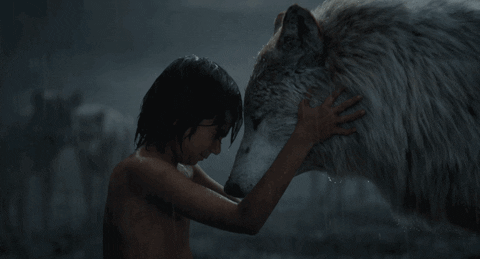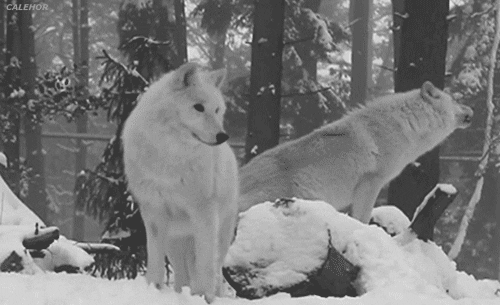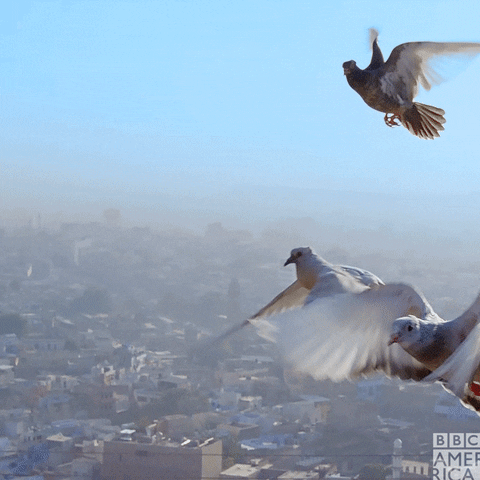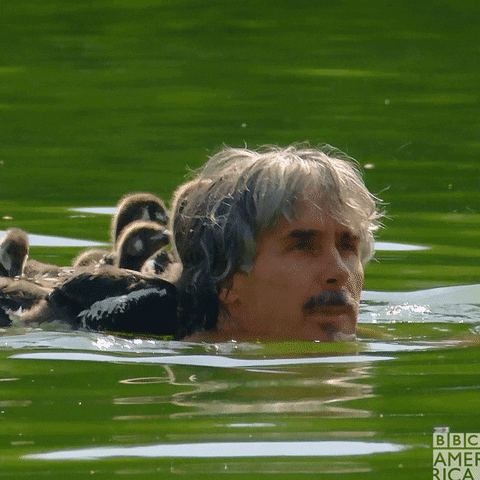
We all have read Rudyard Kiplings famous 1894 work The Jungle Book or seen its movie adaptation.
Dont we all love the famous character Mowgli, who was lost by his parents as a baby in the Indian jungle during a tiger attack, and was adopted by the Wolf Mother, Raksha? He was raised in a pack of wolves and was trained by Bagheera, a black panther.

Credit: Giphy
But did you know that the book was actually based on a real-life person! Many believe that Mowgli was inspired by an Indian boy named Dina Sanichar, who was raised by a pack of wild wolves in the late 19th century.

Credit: Giphy
In fact, there have been similar incidents in late 19th century India where human children were raised by animals in the wild. Such children were known as feral children.
You must be wondering how this is possible!
Well, in order to answer this fascinating question, lets understand what really goes on when a child is born and how it forms its first link to its mother.
Whos Your Momma?

Imagine yourself as a young bird just cracking your way out of an egg. You’ve worked hard to poke and wiggle your way out of the shell, and now you take in the bright, new world all around you. It’s an overwhelming experience, but instinctively, you know that there must be someone around who will take care of you. Finally, your blurry eyes make out some movement this must be the protector!
Luckily, you are a kind of bird who can walk immediately after hatching ( known as precocial birds). You are not as helpless as your fellow friends, who can’t leave the nest till they are grown up a little ( known as passerine birds). Anyway, you waddle your way closer to the movement, and you notice a distinct scent getting stronger. Suddenly, that moving being makes an oddly familiar noise. You finally make your way over. The protector feels warm and soft. So, after your first hard day of work as a hatchling, you’ve done your job and found your parent, so you curl up and go to sleep. This young precocial bird has just imprinted on its mother.
The Science of Imprinting
Imprinting is the process by which a newborn animal learns to recognise the unique characteristics of its parent, typically its mother. Imprinting is a type of learning that happens very early in an animal’s life. This type of learning teaches an animal how to act around others, how to read another animals body language, and if its okay to bite and if so, how hard, and many other skills.

This learning will also teach an animal who to socialise with, who they will end up mating with when they are older, and how to create bonds within their species. Imprinting even teaches animals what species they are.
Is Cross-Species Imprinting Possible?
Well, it sounds weird but it’s true that animal newborns can bond to a “Mother” from a different species. Often all you need to do is stick around to convince a baby that you are its mother.
There is a British nature documentary called Earthflight that shows some of the world’s greatest natural spectacles, all from a bird’s-eye view. Imagine that – seeing the world the way birds do!

Credit: Giphy
Well, the crafty filmmakers took the advantage of one of one of Mother Nature’s tricks called imprinting.

Credit: Giphy
These birds were exposed to a foster parent as soon as they hatched.They then react to this surrogate parent as if it were their mother, following her wherever she goes. If you had grown up thinking your mom was inside that noisy planeor was that noisy planeyou’d have gladly tolerated it, too!

Sometimes animals can even come to believe they are a different speciesfor example, a chick might imprint on a cat if its mother has died.
How Does It Function?
The process of imprinting was popularised by a German zoologist named Konrad Lorenz in the mid-1930s. Lorenz believed that the first sensory stimulus encountered by an animal was immediately, and irreversibly, “stamped” onto its brain.
Lorenz demonstrated this with his famous goslings (thats the baby of a goose!), which had spent their first hours of life with him and subsequently followed him everywhere, thinking that Lorenz indeed was their mother! When they grew up, they preferred the company of humans over fellow birds.

Credit: Giphy
And it wasnt just him that the young birds would attach to as a mother substitute. They would just as easily attach to inanimate objects, such as a pair of gumboots, a white ball and even an electric train if it was presented at the right time.
In fact, there are other instances of cross-species imprinting too, like the orphaned chipmunk adopted by Buffy the Chihuahua. A tiger in Thailand’s Sriracha Tiger Zoo suckling pigletsafter being suckled as a cub herself by a pig.

Now, it may sound friendly and nice to have those cute little birds taking you up as their mother and following you around everywhere, but in reality, for wild animals, its not very healthy.
A human imprinted bird will never be able to be wild. It cant feed itself, it cant recognise fellow birds, and more importantly, it can not recognise predators. And hey, wild animals need to be able to recognise us humans as potential threats in order to keep themselves safe, as well as to keep people safe. As you can imagine, it would be compromising for wildlife to not fear humans.
Can There Be A Mowgli In Real-Life

Credit: Giphy
Technically, yes. Because recognising and bonding with a parent are more dependent on exposure and learning, it’s conceivable that any animal ( humans included ) exposed exclusively to a member of a different species might happily call it momremember the 19th-century children we talked about at the beginning who were raised by animals?
But despite its initial survival value, however, imprinting on something other than your kind can become problematic when you grow up.
Lets go back to Dina Sanichar, the Indian wolf boy who inspired Mowgli. Mowgli the man-cub entranced readers with his fascinating upbringing. Dina, too, was raised by wolves. But unlike Mowgli, Dina did not have such a fantastical life. Dina was mentally stunted even after years of reintegration into human society.
Sanichar growled and grunted like a wolf, walked on all fours, ate raw meat, and sharpened his teeth by gnawing on bones like an animal. Though he wasnt mute, he only made animal voices. People of the orphanage tried to work patiently with the boy and gradually he started eating normally but he never picked up human speech and only made animal noises.

Dina Sanichar
Because Dina spent his formative years among animals, he had a difficult time relating to humans. He was living in that orphanage – eating raw meat, making animal noises and walking on four limbs. Can you imagine how lonely it must have been, to have no one around who could understand him truly. Human caretakers are trying to do everything for the boy yet he cannot communicate his thoughts or feelings to anyone.
But with a bizarre twist of fate, another wolf boy was brought to the same orphanage. He had been found by hunters in Uttar Pradesh’s Mainpuri. The other boy did not speak like Sanichar, and only let out a sad whining sound similar to that of a wolf pup. He made several attempts to run back to the forest, but was unsuccessful.
In the two decades that Sanichar was at the orphanage, the only human friend he made was this boy who was also raised by wolves. Since these boys grew up with animals, they felt more comfortable with them – and each other – than humans.
How Does Imprinting Work In Humans
Do you have a “type”? Are you eager to be around people who remind you of your parents? While these preferences and impulses may not initially appear to have anything in common, they all have one distinct and important thing in common: imprinting.
As we have discussed, imprinting can profoundly impact how babies are raised, both in humans and in other animals, but the phenomenon can extend to many other areas of life. It impacts the ways in which we think, feel, and behave in everyday life, it also affects the relationship we share with our pets.

For example, we can learn different languages as we grow older, but none will come as easily as those we learned in our most formative period.
Imprinting is also considered to be irreversible, or unforgettable, unlike things that are learned later. ( ever wondered why we never forget to ride a bicycle or swim? Yes, you guessed it right imprinting! )
Critical periods in which humans imprint different behaviours can occur at various points in one’s life. While language imprinting comes before the age of five, the learning period for certain social skills is around the age of puberty (that is when our personality type is being formed).

Imagine you go to an ice cream parlour that has just opened up in your locality and try their new Butterscotch chocolate-chip ice cream . You love it so much that now every time you go there, you order the same ice cream. One day, you and your friend are discussing which is the best ice cream flavour and you tell them, Butterscotch chocolate-chip is the BEST ice cream in the world!. Well, your friend does not share your enthusiasm and says that the Black currant is the best! You have not tried the Black currant. And your friend has not eaten your favourite Butterscotch chocolate-chip ice cream. Yet you guys are determined that your ice cream is the best!
Did you know that imprinting is what is behind this little argument! Yes, there is actually a term psychologists have coined to describe this behaviour – “baby duck syndrome”. This syndrome is used to describe when humans imprint on inanimate objects and consider them the best of their kind, because it was the first thing they encountered.
You must have heard your grandpa and grandma saying that children are impressionable. And of course, we have the animal proverb, “you can’t teach an old dog new tricks.” These sayings imply there’s something special about youth: A young person or animal is moldable and teachable. On the same token, this means that whatever you will learn right now, you will always remember it.
So what skill would you like to learn? Any language you wish you were taught when you were born? Tell us in the comment section below.
Like this story? Read similar stories at The Learning Tree
The Mixed-Up World Of Hybrid Animals
As a true introvert, Raza Mehdi shudders at the thought of having to expose very much of himself willingly and with malice-aforethought. Writing online since 2008; fiction, poetry, and articles on science, politics, humour and history. When he is not working, he is either trekking in mountains or sleeping. In his own words, the most apt description of him would be: Biryani on social media, daal chawal in person.
Comments
Trrishan Saha
October 21, 2020
Wow! These “mowglis” may also know the animal Language!
Yashika
October 31, 2020
There is Mowgli in real life
Sampurna Lahiri
November 30, 2020
Why are you guys not adding anything new since many days ??